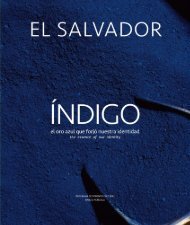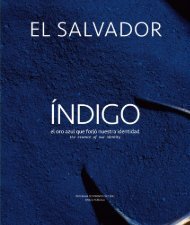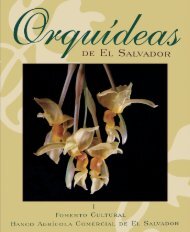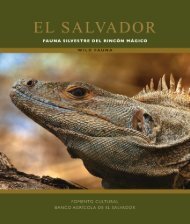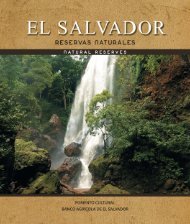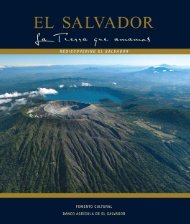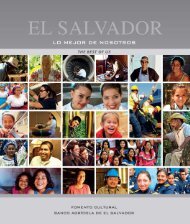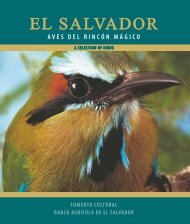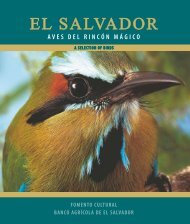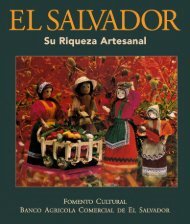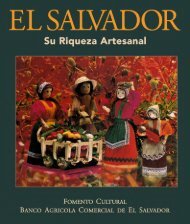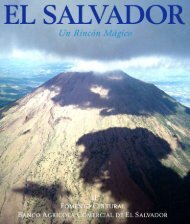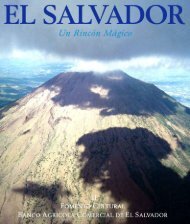Monumentos y Esculturas
You also want an ePaper? Increase the reach of your titles
YUMPU automatically turns print PDFs into web optimized ePapers that Google loves.
Representación de La Victoria,<br />
monumento al Primer Grito de<br />
Independencia, Plaza Libertad.<br />
Representation of Victory,<br />
monument to the first attempt<br />
Independence, Plaza Libertad.<br />
L<br />
a ciudad puede interpretarse como un espacio de memoria y la<br />
escultura monumental como uno de los elementos que identifica<br />
esa memoria. En San Salvador, monumentos y esculturas nos<br />
recuerdan cómo se formó la nación, quiénes fueron sus héroes y las<br />
batallas que libraron, y los eventos que han marcado la historia moderna<br />
del Estado.<br />
El unionista Francisco Morazán, el presidente general Gerardo Barrios<br />
y los próceres de la independencia José Matías Delgado, Juan Manuel<br />
Rodríguez y Manuel José Arce marcan la iconografía nacional a inicios<br />
del siglo XX. Los cambios culturales, sociales y políticos entre 1930<br />
y 1950 entregan a los salvadoreños nuevos héroes, más cercanos,<br />
inspirados en nuevos ciudadanos: comunes, trabajadores, que se abren<br />
a la Historia como protagonistas de acontecimientos importantes<br />
como la Revolución de 1948, convertida en monumento en 1955, y la<br />
Constitución de 1950, inmortalizada en 1956, o el Monumento al mar<br />
de 1970.<br />
La escultura monumental en El Salvador atraviesa dos periodos que van<br />
a marcar su tradición escultórica: El primero, de corte épico, de 1880<br />
a 1930, y el segundo, o en búsqueda la identidad, donde predomina la<br />
escultura de autor, de 1950 a 1970.<br />
T<br />
he city could be interpreted as a space that honors its<br />
memory and the monumental sculpture as one of the elements<br />
that identify this memory. In San Salvador, monuments and<br />
sculptures remind us how the nation was formed, who were its heroes,<br />
the battles they fought, and the events that have marked the modern<br />
history of the State.<br />
The unionist Francisco Morazán, the president general Gerardo Barrios,<br />
and the Independence illustrious José Matías Delgado, Juan Manuel<br />
Rodríguez, and Manuel José Arce mark the national iconography at the<br />
beginning of the XX century. The cultural, social, and political changes<br />
between 1930 and 1950 deliver to the Salvadoreans closer new heroes,<br />
inspired in new citizens; common and workers. They come in and make<br />
History becoming the protagonists of important milestones such as the<br />
Revolution of 1948, turned into monument in 1955, and the Constitution<br />
of 1950, immortalized in 1956, or El Monumento al Mar of 1970.<br />
ESCULTURA ÉPICA<br />
Entre 1880 y 1930, San Salvador se convierte en una ciudad<br />
ilustrada: una ciudad con servicios básicos sanitarios como<br />
acueductos, hospitales, cementerio, espacios para caminar y<br />
convivir. Las plazas, con sus árboles y bancas, son los lugares, de<br />
convivencia de los capitalinos y en ellas se eregirán los primeros<br />
ejercicios de memoria de la historia nacional: las esculturas<br />
monumentales.<br />
En esta etapa predomina la estatuaria clásica grecorromana de<br />
mármol y bronce, una alusión a la cultura clásica, fundadora de la<br />
estética y cosmovisión de Occidente. La difusión de los héroes,<br />
próceres y militares, dará un sentido épico a la escultura.<br />
Las esculturas de este periodo son talladas en mármol, por lo<br />
general de la cantera italiana de Carrara, o fundidas en bronce.<br />
Las principales son el Monumento a Morazán, inaugurado en<br />
1882; el Monumento ecuestre de Gerardo Barrios, de 1910; el<br />
Monumento al Primer Grito de Independencia de 1811, construido<br />
para el centenario en 1911.<br />
En este periodo es muy importante la influencia del italiano<br />
Francesco Durini (1856-1920), quien erige una serie de<br />
monumentos públicos y funerarios en Guatemala, El Salvador<br />
y Ecuador, entre finales del siglo XIX e inicios del XX. De su<br />
compañía vienen las esculturas en mármol y bronce, que se<br />
convierten en referencia de la historia salvadoreña.<br />
La herencia escultórica salvadoreña debe mucho a la figura<br />
de Durini, quien además construye y diseña, en esta época,<br />
mausoleos impresionantes en los principales cementerios del país<br />
como San Salvador y Santa Ana, y participa en la construcción<br />
del Teatro de Santa Ana, una de los edificios más importantes<br />
de su época.<br />
Esta etapa de héroes neoclásicos –figuras ecuestres, musas y<br />
dioses grecorromanos, relieves de batallas- se rompe en 1928<br />
cuando viene, de España, la escultura del indio Atlacatl, obra<br />
del maestro salvadoreño Valentín Estrada, y es colocada en el<br />
Paseo Independencia de San Salvador.<br />
EPIC SCULPTURE<br />
Between 1880 and 1930, San Salvador turns into an illustrated city;<br />
a city with basic health services such as aqueducts, hospitals,<br />
cemetery, and spaces to walk and coexist. The plazas, with its<br />
trees and benches, are the places to socialize for the citizens<br />
and in them, they would erect the first memory exercises of the<br />
national history: the monumental sculptures.<br />
In this stage predominates the classic Greco-Roman statuary<br />
of marble and bronze; an allusion to classic culture, founded by<br />
the aesthetic and cosmo vision of the West. The diffusion of<br />
heroes, illustrious and militaries, will give an epic sense to the<br />
sculpture.<br />
The sculptures of this period are carved in marble, in general<br />
from the Italian quarry of Carrara, or cast in bronze. The most<br />
important ones are the Monument to Morazán, inaugurated in<br />
1882; the equestrian Monument of Gerardo Barrios, of 1910; the<br />
Monument to the First Attempt of Independence in 1811, built for<br />
the century in 1911.<br />
In this period, the influence of the Italian Francesco Durini (1856-<br />
1920) is very important. He erects a series of public and funerary<br />
monuments in Guatemala, El Salvador, and Ecuador; at the end of<br />
the XIX century and beginning of XX century. From his company<br />
comes the sculptures in marble and bronze, which turn into<br />
reference of the Salvadorean history.<br />
The Salvadorean sculptural heritage owes much to the figure<br />
of Durini, who also built and designed, during this era, many<br />
impressive mausoleums in major cemeteries around the country,<br />
in cities such as San Salvador and Santa Ana. He also participated<br />
in the construction of Santa Ana’s Theater, one of the most<br />
important buildings of his time.<br />
This stage of Neoclassical heroes – equestrian figures, muses,<br />
and Greco-Roman gods, embossments of battles- is broken<br />
in 1928; when the sculpture of Atlacatl, the Indian, work of<br />
Salvadorean master sculptor Valentin Estrada arrived, coming<br />
from Spain. It was placed in Paseo Independencia in San Salvador.<br />
The monumental sculpture in El Salvador goes through two periods<br />
that will mark its sculptural tradition: The first one, of epic cut, from<br />
1880 to 1930, and the second one, in the search for identity, where<br />
predominates the author sculpture, from 1950 to 1970.<br />
Fue Atlacatl la primera obra esculpida por un salvadoreño que se<br />
coloca en el espacio público y comienza una etapa en las artes<br />
que se caracteriza por la búsqueda de la identidad nacional. El<br />
atrevimiento histórico de Estrada permitirá repensar la identidad<br />
salvadoreña a partir de sus pueblos originarios y más allá de los<br />
héroes criollos a caballo.<br />
Atlacatl was the first sculpture made by a Salvadorean, which<br />
was placed in a public area and it started one stage in the fine arts<br />
characterized by the search of national identity. Estrada’s historic<br />
boldness would enable rethinking Salvadorean identity based on<br />
its native people and beyond Creole heroes riding horses.<br />
78 79



